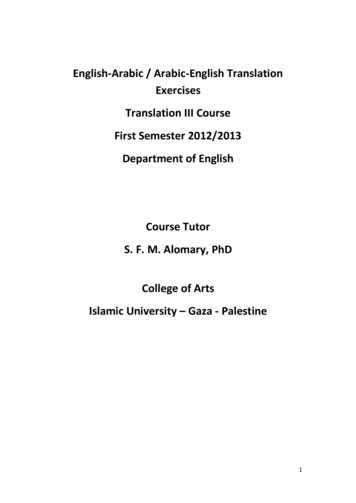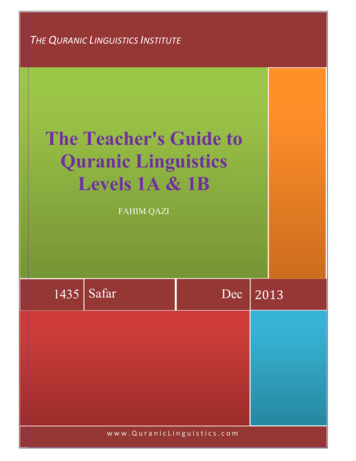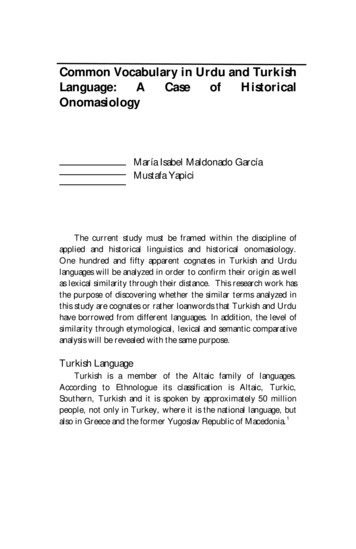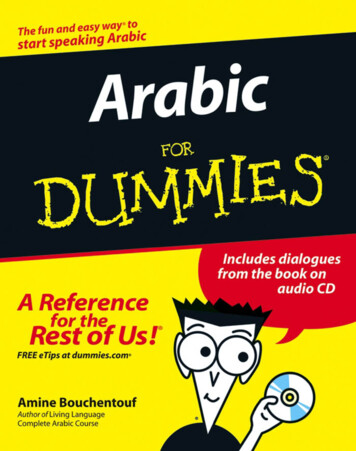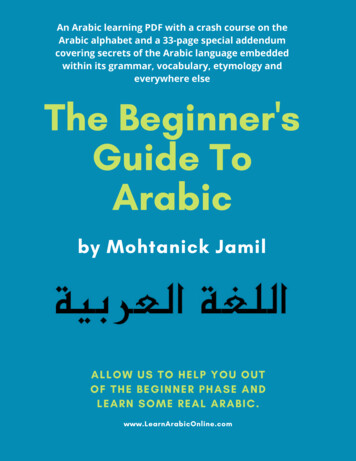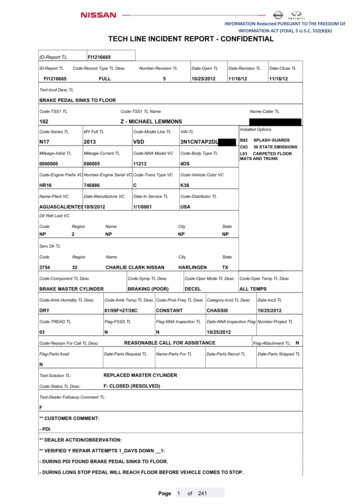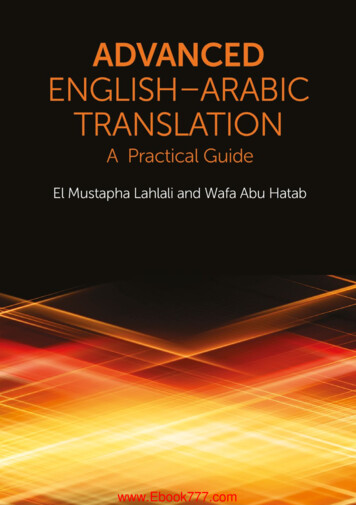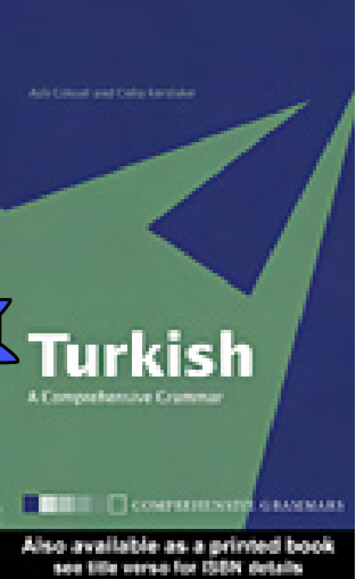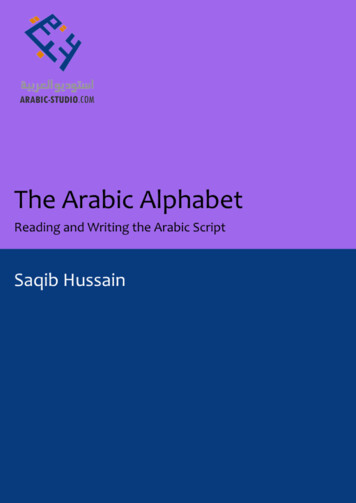
Transcription
Course Code: TAS001AThe ArabicAlphabetReading and Writing theArabic ScriptSaqib Hussain Saqib Hussain 2009. All rights reserved. No part of this document may be reproduced, stored ortransmitted in any form or by any means, electronic or otherwise, including photocopying,recording, Internet, or any storage or retrieval system without prior written permission from thecopyright holder.
ContentsIntroduction.21The Alphabet.3AThe Primary Letters.3BPronunciation.4CSupplementary Letters.52Writing.73The Vowels and the Sukūn.1045AThe Short Vowels and the Sukūn.10BLong Vowels.10CDiphthongs.11DShaddah / Tashdīd.12ETanwīn / Nunation.12FPausing when Speaking or Reading Aloud.12The Two Hamzahs.14AThe Permanent Hamzah.14BThe Connecting Hamzah.16Elision.17AThe Sun and Moon Letters.17Appendix A.201
IntroductionThere are five free video lectures which accompany this text. They can be downloaded atwww.arabic-studio.com.This course has been designed to teach the complete beginner how to read and write the Arabicscript. It assumes no prior knowledge of Arabic.The course covers most of the rules a beginner needs to correctly read and pronounce Arabic.However, a few rules can only be fully understood and applied after learning some grammar, andthese will be covered in the course Basic Arabic Grammar (TAS004A).In Appendix A at the end of this text, an alphabet cut-out has been provided, which the student canuse to make alphabet cards. These can be used to practice letter recognition and for writingexercises, as explained in the accompanying video lectures.2
1 The AlphabetA The Primary LettersThere are twenty-eight letters in the Arabic alphabet, shown in the table below. For each letter, thetable also gives the transliteration of its name, and an example English word which begins with thesound made by that letter. Some letters don't have a corresponding English sound; the correctpronunciation for these is given in §1B.LetterTransliteration of the letter'snameEnglish word which beginswith the sound of this letter ا alif(see §1C) ب bā book ت tā table ث thā thin ج jīmjack ح ḥā - خ khā - د dāldolly ذ dhālthat ر rā - ز zāyzebra س sīnsun ش shīnshatter ص ṣād- ض ḍād-3
ط ṭā - ظ ẓā - ع ˁayn- غ ghayn- ف fā fat ق qāf- ك kāfking ل lāmlight م mīmmad ن nūnnight ه hā hello و wawwing ي yā yellowB PronunciationMost Arabic letters have an English equivalent, as you will have noticed from the previous section.A few, however, don't have corresponding English sounds. The correct way to pronounce these is asfollows: ح This is similar to the English h, except that you must constrict the throat when خ This sound is sometimes heard in Scottish English; it is like the ch in the word 'loch'. ر Imagine isolating a single 'tap' which the tongue makes when roll your r's - that's theexhaling, as is sometimes heard in the exclamation: 'aha!'sound you need for this letter. It is often heard in Scottish English for the letter r, suchas in the word 'free'.4
ظ ط ص These are deeper, or emphatic, versions of 1 س , 1 ت and 1 ذ respectively. In eachcase, the tongue is pressed harder against the mouth, although its position (i.e. thepoint of contact with the mouth) doesn't change. At the same time, the back of thetongue is raised, which constricts the pharynx. For this reason, these letters aresometimes said to be pharyngealized. ض This is a difficult sound to get right. It is made by using the left or right side of thetongue with the premolar and molar teeth. It is again a deep sound, and as a firstapproximation may be considered the emphatic version of 1 د . Along with the abovethree letters, 1 ض is also said to be pharyngealized for the same reasons. ع This is not quite a glottal stop (see §1C), but very close. Its sound is made by thethroat constricting, much as it does for 1 ح , except even more tensely, allowing lessair to escape. غ This is similar to the gurgling sound in English. ق This is roughly similar to the English k, but is pronounced from the part of the tongueclosest to the throat (i.e. the uvula).C Supplementary LettersAs well as the above twenty-eight letters, there are three supplementary letters. These aren't usuallyincluded in the alphabet, but are used frequently nonetheless.Hamzah (! زة #% ه # )The hamzah is written: 1 ء , and is represented in transliteration by a single inverted apostrophe: .It represents a glottal stop. Although there isn't an equivalent letter for this sound in the Englishalphabet, English speakers still make this sound all the time: At the beginning of words: when pronouncing a word which begins with a vowel, such as'in', 'on' and 'at'.5
In the middle and end of words: in some English dialects, such as Cockney, it replaces the tin the middle and end of some words and phrases, such as 'fitness', 'what if', and 'shut up'.If the hamzah occurs at the start of a word, it is always written 'sitting' on top of or beneath an 1 ا ,like this: 1 أ and 1 ( إ see §4). For this reason, it is sometimes said that 1 ا is for 'apple'. In fact, it isthe hamzah sitting on top of the 1 ا which gives us the glottal stop at the beginning of 'apple'.More details about the hamzah are given in Section §4.Tā Marbūṭah ( ة # وط % ./ رب % م # ! تء # ت #)This is written: 1 ة , i.e. 1 ه with two dots above, and it may be thought of as a mixture of 1 ه and1 ت . It only ever occurs at the end of a word. When speaking or reading aloud, if we stop at a wordwhich ends in 1 ة , such as at the end of a sentence, or to draw breath, then we pronounce it as a ه 1 . Otherwise, we pronounce it as a 1 ت .More details about the rules for speaking and reading aloud are given in §3F.6Alif Maqṣūrah (! رة # و % ص ! ل # )أ . ق % م # ف This is written: 1 ى . It is written like a 1 ي , but without two dots beneath it. It also only occurs atthe end of a word, and is used to form long vowels (see §3B).6
2 WritingArabic is written from right to left. Most of the letters in an Arabic word have to be joined together,like joined-up handwriting in English. There are however six letters which can't be joined on to anyother letter which comes after them: و ز ر ذ د ا To write Arabic, we need to know what each letter looks like in its initial form (i.e. when there is aletter attached after it only), its medial form (i.e. when there is a letter on both sides of it), and itsfinal form (i.e. when there is a letter attached before it only). In the table below, you can see theelectronic or printed forms of the letters. The hand-written forms of a few of the letters is slightlydifferent from the printed forms, and is covered in the video lectures.Isolated FormFinal FormMedial FormInitial Form(A letter attached before it only)(Letters attached on both sides)(A letter attached after it only) ا ـا ب ـب ـبـ بـ ت ـت ـتـ تـ ث ـث ـثـ ثـ ج ـج ـجـ جـ ح ـح ـحـ حـ خ ـخ ـخـ خـ د ـد Cannot attach a letter after it. ذ ـذ Cannot attach a letter after it. ر ـر Cannot attach a letter after it. ز ـز Cannot attach a letter after it.Cannot attach a letter after it.7
سـ ـسـ ـس س شـ ـشـ ـش ش صـ ـصـ ـص ص ضـ ـضـ ـض ض طـ ـطـ ـط ط ظـ ـظـ ـظ ظ عـ ـعـ ـع ع غـ ـغـ ـغ غ فـ ـفـ ـف ف قـ ـقـ ـق ق كـ ـكـ ـك ك لـ ـلـ ـل ل مـ ـمـ ـم م نـ ـنـ ـن ن هـ ـهـ ـه ه Cannot attach a letter after it. ـو و ـي ي يـ ـيـ 8
In addition, there are some combinations of letters which join together in special ways. It isrecommended that the student just pick these combinations up as he or she progresses. The only oneto bear in mind at this stage is a 1 ل followed by an 1 ا :Isolated Form ل Final FormMedial FormInitial Form(A letter attached before it only)(Letters attached on both sides)(A letter attached after it only) ل /Cannot attach a letter after it.9
3 The Vowels and the SukūnA The Short Vowels and the SukūnIn English, we use the five vowels a, e, i, o and u after the consonants to show what sound eachconsonant should make (e.g. 'ma', 'me', 'mo').In Arabic, we use diacritical marks in place of vowels. These are signs made above and below theletters. The three short Arabic vowels are shown in the table below:VowelExampleTransliterationEnglish word whichbegins with this soundḍammah (! مة : ض # ): ﹹ ف .fufootfatḥah (! حة # ت %/# )ف : ﹷ ر #rarunkasrah (! رة # س % ك # ): ﹻ 6 ب bibitLetters in English may be unvowelled, i.e. have no vowel sound immediately after them, such as then, the s and the c in the word 'fantastic'. In Arabic, we show this using a diacritical mark called acalled a sukūn ( كو !ن . س . ) above the unvowelled letter: ﹿ .ExampleTransliteration ل % . ق qul ل % ه # ن % م 6halminB Long VowelsA long vowel is just a lengthened vowel sound. In English, we usually form long vowels by using adouble-vowel, e.g. 'fool' and 'weep'. Long vowels in Arabic are formed in the following manner: 1 و %./ (i.e. any letter which has a ḍammah, followed by a 1 و with a sukūn)10
1% ا #/ and 1 ى % #/ (i.e. any letter which has a fatḥah, followed by an 1 ا or an 1 ى with a sukūn) 1 ي % 6/ (i.e. any letter which has a kasrah, followed by a 1 ي with a sukūn)As such, the letters 1 و , 1 ا and 1 ي are said to 'correspond' with the vowels ḍammah, fatḥah andkasrah respectively.Consider the examples in the table below:Long VowelExampleTransliterationEnglish word whichbegins with this sound و %./ و % ش .shūshoot% ا #/% ها #hāheart ي % 6/ ف % 6fīfeetIn a few words, we use the sign 1 —ـ above a letter to indicate a long fatḥah vowel, in place of 1% ا /#/ ,such as above the 1 م in 1 ن . ح Q % ر # Gracious (instead of 1 ن . % ا # ح % ر # ).When a hamzah is followed by an 1% ا , we write it as 1 آ , such as in the word 1 رآ !ن %/. ق Quran. This signabove the 1 ا is called a maddah (! دة : م # ).C DiphthongsDiphthongs are combinations of two vowels in a single syllable, as in the words 'coin', and 'loud'. InArabic, there are two diphthongs, which are formed in the following manner:DiphthongExampleTransliterationEnglish word whichbegins with this sound و %#/ و % # ل lawlonely ي % #/ ي % و #waywaitD Shaddah / TashdīdMany vowelled letters in Arabic have a ﹽ sign with their vowels. This is called a shaddah (! دة : ش # ), or11
tashdīd ( !د % دي 6 / ش /% # )ت . It indicates a double-letter, the first of which has a sukūn, and the second haswhatever vowel appears with the shaddah.Consider the examples in the table below. Note that where we have a kasrah, it is written beneaththe shaddah (rather than beneath the letter, as is usually the case).ExampleWhat the shaddah indicatesTransliteration ك a# جد # ك # د . د % ج #jadduka م # : عل # ل # f6 ت /. ق م # # لل % ع # ل # 6 تت %/. ق ˁallamaquttilaE Tanwīn / NunationThe ends of some Arabic words take two vowel markers (e.g. a double-kasrah: 1 ) ـ . This is knownas tanwīn ( !ن % وي 6 ن %/# )ت , or nunation. It indicates a final n sound after the vowel.In the examples below, note the way in which the ḍammah tanwīn is written: 1 ـ . Also, note thatwhen a word ends with a fatḥah tanwīn, we add a final 1 ا to the word1, which can usually just beignored (but see the next section).ExampleTransliteration ل !م % ع 6 ما h ل % ع 6 م i ل % ع 6ˁilmunˁilmanˁilminF Pausing when Speaking or Reading AloudWhen speaking Arabic or reading it out loud, we usually don't pronounce the last short vowel ortanwīn of the word we stop at. For example, we would read aloud the sentence 1 ر i % ا # ح 6 ى # عل # س # جل % # # He saton a donkey, as 1 ر %% ا # ح 6 ى # عل # س # جل # . In other words, we ignore the tanwīn on the final letter 1 ر , and treatit as if it had a sukūn.%#1 This is further discussed in the course Basic Arabic Grammar - Part A (TAS004A).12
The exception to this is when the final word ends in 1 ا h/ , i.e. a fatḥah tanwīn. In this case we read itwith the long fatḥah sound: ā. For example, we would read the sentence 1 ب h % ا # ت 6 ت ك . ع % 6 ب I sold a book, as 6 ب 1 ب # % ا # ت 6 ت ك . ع % .13
4 The Two HamzahsThere are two types of hamzahs in Arabic; the permanent hamzah ( ع 6 / % قط # % ال . زة #/ % ه # ) and the connectinghamzah ( ل 6 ص % و # % ال . زة #% ه # ).A The Permanent HamzahThe permanent hamzah can be written in a number of ways: It can 'sit' above the 1 ا , 1 و or 1 ( ي i.e. 1 أ , 1 ؤ and 1 ئ - note that we remove the twodots from the 1 ي when the hamzah is sitting on it); It can sit beneath the 1 ( ا i.e. 1 ;) إ It can sit 'on the line' - in other words neither above nor beneath another letter (i.e. 1 ) ء .The correct way to write the hamzah in any given word will depend on its position within that word,and the vowels before it and on it.The Beginning of a WordAt the beginning of a word, the hamzah sits above the 1 ا if it takes a ḍammah or a fatḥah, andbelow the 1 ا if it takes a kasrah:WordTransliterations م . أ ummun خ #! أ akhun ن % 6 إ inThe End of WordAt the end of a word, the hamzah sits on the letter which corresponds (see §3B) to the short vowelimmediately before it. If there is a sukūn or a long vowel immediately before the hamzah, then itsits on the line.14
WordTransliteration ؤ # ر . ج #jaru a. رأ # ق % /# ي ئ # 6 مل .yaqra u! زء % ج .juz un6! ء % ا # بن binā unmuli aThe Middle of a WordIn the middle of a word, we need to consider (i) the long or short vowel immediately before thehamzah, and (ii) the vowel on the hamzah itself. We then apply the following rules in the followingorder:1. If either (i) or (ii) is a kasrah, then the hamzah sits on a 1 ي , otherwise go to Rule 2 below;2. If either (i) or (ii) is a ḍammah, then the hamzah sits on a 1 و , otherwise go to Rule 3 below;3. If either (i) or (ii) is a fatḥah, then the hamzah sits on an 1 ا , unless it occurs after an 1% ا , inwhich case go to Rule 3.a below:3.aThe hamzah sits on the line.One must apply the above rules in the correct order. So, for example, if Rule 1 applies, then wedon't need to worry about Rules 2 and 3.There are a few exceptions to the above rules, which the student should learn as he or sheprogresses.15
RuleWordTransliteration1 ل # 6 سئ .su ila2 س # ؤ . /# ب ba usa3 م ## شأ #sha ama3.a ن # و %. ل # ء % سا # # ت /# ي yatasā alūnaB The Connecting HamzahThis is only ever used at the start of a few words (and therefore always sits above or below an 1 ) ا .For example, the word 1 س !م % 6 إ name starts with a connecting hamzah.We only pronounce the connecting hamzah when the word in which it occurs is at the start of asentence (or a pronouncement). To show this, we don't usually write the hamzah - we just write thevowel that it takes above or below the 1 ا , e.g. 1 س !م % 6 ا .You should note that whenever a word appears to begin with 1 ا , it is in fact beginning with aconnecting hamzah, which is invisibly sitting above or below the 1 ا .When the word which starts with a connecting hamzah occurs in the middle of a sentence (orpronouncement, in spoken Arabic), the hamzah is totally ignored. To indicate this, we can use thesymbol 1 ›ـ above the 1 ا , e.g. 1 ﭐس !م % . More often, we just show the 1 ا by itself: 1 اس !م % . So we wouldread the sentence 1% ها # د 6 / # ل /# م ب # / اس . ر 6 / ع % /# ن We know the name of her city, as 1% ها # د 6 / # ل /# م ب # / س % ف . ر 6 / ع % /# ن , as if the 1 ا % ف weren't there.16
5 ElisionSome combinations of consonants are difficult to say, so we leave out some of the sounds. Forexample, when we say the phrase 'next day', we usually leave out the final t of the first word, as if itwere 'nex day'. This is called elision: the t is elided into the d because it is too difficult to pronounceboth of them together.The same principle applies in Arabic, particularly in the Arabic of the Qur ān and ḥadith literature.Elision can occur between two letters if the first has a sukūn, and the second is vowelled. If it isdifficult to pronounce the two letters together, then the first is elided into the second. To show this,the first letter loses its diacritical mark (it becomes 'silent', like the t in the above example, and so isignored) and second takes a shaddah.Consider the examples below, which are all taken from the Qur ān. You can see the vowels on eachphrase before and after elision.Letters which are elidedBefore ElisionAfter Elision ن elides into ر ن elides into ل م % 66 ب f ر # ن % م 6% ن : د . # ن ل % م 6 م % 66 ب f ر : من 6% ن : د . : من ل 6 د elides into ت ت %. د % # عب # دت %a # عب # ذ elides into ظ م % . مت % # ل # ذ ظ % 6 إ م % . مت % # ل : ذ ظ 6 إ All letters elide into themselves م % . ت / ب % س # ك # % ما # م % ك . # ل م % . ت / ب % س # ك # % ما : كم . # ل The complete rules for how letters elide are studied as part of the subject called tajwīd, and will notbe dealt with here.A The Sun and Moon LettersThe word for 'the' in Arabic is 1 ل % # ا . When we want say 'the boy', for example, we take the word forboy, 1 !د # ول # , and attach 1 ل % # ا to the beginning: 1 د . # ول # % ل # ا .However, when 1 ل % # ا is attached to words beginning with certain letters, known as the Sun Letters,we have to elide the 1 ل into the sun letter with which the word begins. For the rest of the letters in17
the alphabet we don't elide the 1 ; ل these are called the Moon Letters.Moon LettersExampleTransliteration ء م . % عا # /% ن # ل # ا al-anˁām ب . رة # ق # /# ب % ل # ا . ة # ي 6 ث % ا # ل % # ا ر . ج % 6 ل % # ا al-baqarah ج ح al-jāthiyahal-ḥijr خ ن # و % ر . س 6 % ا # ل % # ا al-khāsirūn ع ت . و % /. كب # ن % ع # % ل # ا al-ˁankabūt غ . ة # شي 6 % ا # غ % ل # ا al-ghāshiyah ف ن . % ا # رق % ف . % ل # ا al-furqān ق ص # ق # % ل # ا . ص al-qaṣaṣ ك ف . ه % ك # % ل # ا al-kahf م . دة # 6 ئ % ما # % ل # ا al-mā idah ه al-humazah ي . زة # م #. ل % # ا . عة # 6 ق % وا # % ل f ا 6 ي . % ق # ي % ل # ا Sun LettersExampleTransliteration ت at-tawbah ث . ة # وب :% / لت # ا 6 ب . ق % ا : لث # ا د ن . خا a# لد # ا ad-dukhān ذ ت . % ي # ر 6 % ذا : ل # ا adh-dhāriyāt و 18al-wāqiˁahal-yaqīnath-thāqib
ر د . ع % ر : ل # ا ar-raˁd ز ر . م # ز a ل f ا az-zumar س . دة # ج % س : ل # ا as-sajdah ش # لش # ا . ء % را # ع aash-shuˁarā ص ات : ل # ا . : صاف aṣ-ṣāffāt ض حى a# لض # ا aḍ-ḍuḥā ط ر . و %a لط f ا ن # و % م . 6 ل % ا : لظ # ا ظ ل ن aṭ-ṭūraẓ-ẓālimūna ب . ه # : لل # ا 6. ء % سا # f لن # ا al-lahaban-nisā Note that 1 ل % # ا begins with a connecting hamzah. So if the 1 ل % # ا is attached to a sun letter and occursin the middle of a sentence, it means we ignore both the hamzah (as it is a connecting hamzah), and# ت ال the 1 ل , (as it is elided into the sun letter), e.g. 1 شجرة # ت %# س # جل # he sat under the tree.#19
Appendix A ا ب ت ث ج ح خ د ذ ر ز س ش ص ض ط ظ ع غ ف ق ك ل م ن ه و ي ء ة ى 20
ر%./ق Quran. This sign above the 1 ا is called a maddah (!ةد:م#). C Diphthongs Diphthongs are combinations of two vowels in a single syllable, as in the words 'coin', and 'loud'. In Arabic, there are two diphthongs, which are formed i
